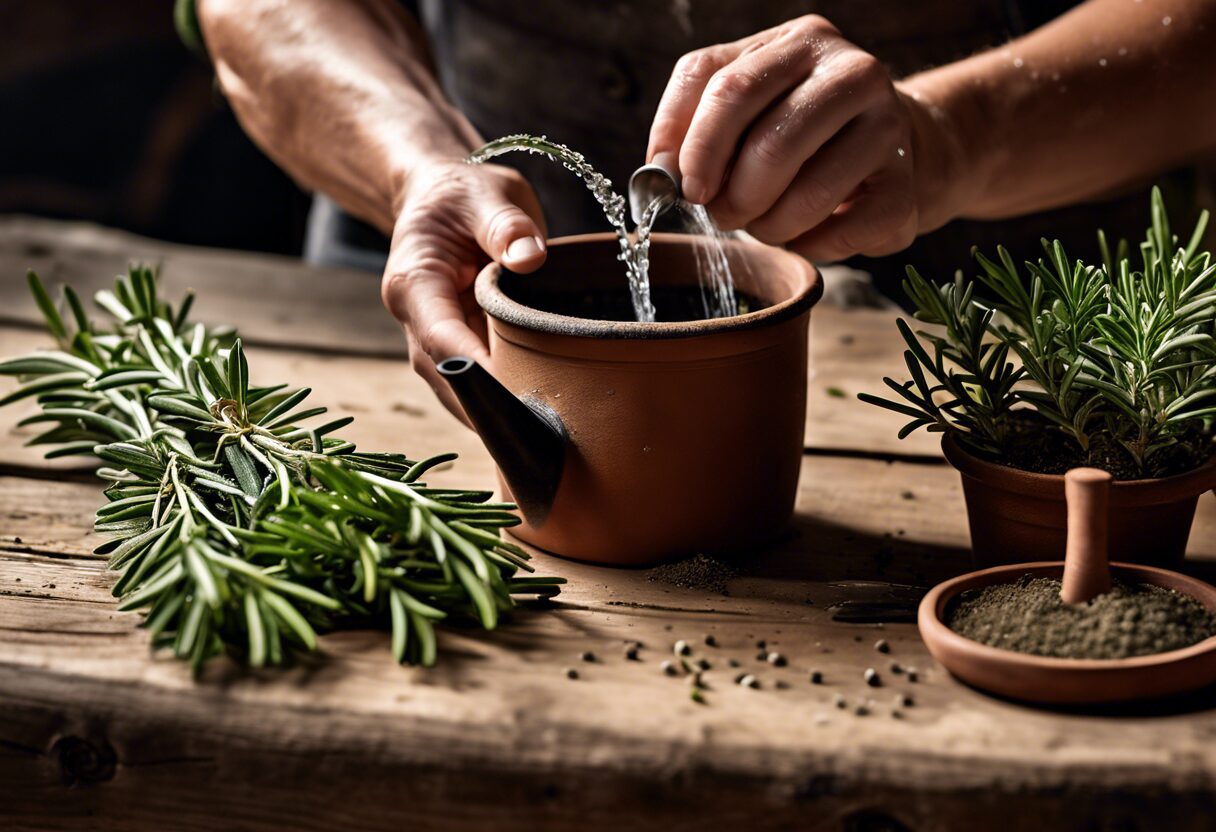Hello there, fellow plant enthusiasts! Ever found yourself wondering How to Water Rosemary Plants? I’ve been there, trust me. It’s like a guessing game with these green buddies – too much and they’re drowning, too little and they’re parched!
Don’t fret though. In this post, we’ll dive into the nitty-gritty of keeping your rosemary plants hydrated and happy. So sit back, grab a cuppa, and let’s turn that brown thumb green. Keep reading about How to Water Rosemary Plants!
Key Takeaways
- Water rosemary plants when the top inch of soil is dry to touch.
- Overwatering can cause root rot, so ensure proper drainage.
- Use a watering can or hose with a gentle spray to avoid damaging the plant.
- In winter, water less frequently as rosemary prefers drier conditions.
- Indoor rosemary needs more frequent watering than outdoor plants due to lower humidity.

Understanding Rosemary Plant’s Watering Needs
When it comes to rosemary plant care, knowing how much H2O to give your green buddy is crucial. It’s all about understanding the watering needs of rosemary plants and maintaining a healthy balance.
The Nature of Rosemary Plants
Rosemary plants are like that friend who loves a good sunny day but hates getting their feet wet. They’re native to the Mediterranean, so they’re used to dry, well-drained soil and lots of sunshine. These rosemary plant characteristics play a big role in their care.
Understanding the nature of rosemary plants can help you provide the right amount of water. Too much, and you’ll have a soggy mess on your hands. Too little, and they’ll be as parched as a desert cactus on a hot summer day.
How Much Water Does a Rosemary Plant Need?
Now, let’s talk about how much water for rosemary is just right. Typically, these hardy herbs need watering once every 1-2 weeks during growing season. But remember, factors like temperature, humidity, and soil type can affect this schedule.
For instance, if you’ve got sandy soil that drains faster than your bathtub after a long soak, you might need to water more often. On the flip side, clay soils hold onto water longer – so go easy on the watering can! It’s all about finding that sweet spot for optimal watering for rosemary plants.
Signs of Overwatering and Underwatering in Rosemary Plants
So how do you know if your rosemary is getting too much or too little water? Well, there are signs to look out for. If your plant has yellow leaves or soft stems, it might be screaming “Help! I’m drowning!” – classic overwatering signs in roses.
On the other hand, if the leaves are wilting or turning brown, your rosemary might be as thirsty as a camel after a long trek. These are common underwatering symptoms in roses.
But don’t worry! Correcting these issues is easier than you think. For overwatered plants, reduce watering frequency and ensure good drainage. If underwatered, increase watering gradually until your plant perks up again. Remember, understanding how to water rosemary plants is key to their survival and growth!
Best Practices for Watering Rosemary Plants


When it comes to rosemary plant care, the watering game is a delicate balance. Too much or too little, and you’re in trouble. So, let’s dive into how to water rosemary plants effectively.
When to Water Your Rosemary Plant
The best time to water your rosemary? Early morning or late evening. This gives the plant ample time to absorb the moisture before the sun gets too intense. Keep in mind, though, that seasonal watering of rosemary plants changes with climate shifts.
In hot summer months, for example, your rosemary might need more frequent hydration. On the other hand, during cooler seasons or in more temperate climates, less frequent watering is usually sufficient. It’s all about tuning into your plant’s needs and adapting as necessary.
How to Water Your Rosemary Plant Properly
Now onto the nitty-gritty: how to water your rosemary plant properly. You want to aim for deep and infrequent watering sessions rather than shallow and frequent ones. This encourages the roots of your rosemary plant to grow deeper into the soil, promoting overall health and stability.
Start by soaking the soil thoroughly until you see water draining out from the bottom of the pot or ground (if planted directly). Then wait until the top inch of soil feels dry before watering again. Remember: overwatering can lead to root rot – a surefire way to bid farewell to your beloved herb!
Factors Affecting the Frequency of Watering
There are several factors that influence how often you should be reaching for that watering can when it comes to maintaining rosemary plants. Soil type is one such factor – sandy soils drain faster than clay-based ones, meaning they require more frequent watering.
Weather conditions also play a significant role in determining your rosemary plant hydration schedule. Hot, dry weather can cause the soil to dry out faster, necessitating more frequent watering. Conversely, in cooler or rainy conditions, you’ll want to scale back on watering to prevent waterlogging.
Remember: every rosemary plant is unique and will have its own hydration needs. Stay observant and responsive to your plant’s signals for the best results!



Special Considerations for Indoor and Outdoor Rosemary Plants
When it comes to rosemary plant maintenance, location matters. Whether your rosemary is basking in the sun outdoors or enjoying the controlled climate indoors, its watering needs will differ. Let’s dive into the specifics of indoor vs outdoor plants.
Watering Indoor Rosemary Plants: Key Differences and Tips
Indoor rosemary care can be a bit tricky. These plants love sunshine and well-drained soil, but they’re not fans of dry indoor air. So, how do you keep your indoor herb happy? It’s all about balance.
Firstly, consider the temperature. If it’s too hot, your plant might dry out faster than you’d expect. On the flip side, if it’s too cold, water won’t evaporate as quickly which could lead to overwatering.
Next up is light exposure. Rosemary loves sunlight – so make sure your plant gets plenty of it! But remember, more light means more evaporation – so you might need to water more frequently.
Lastly, let’s talk humidity. Low humidity levels can cause rosemary to dry out quickly. To combat this, try misting your plant regularly or placing it near a humidifier.
Watering Outdoor Rosemary Plants: Key Differences and Tips
Outdoor rosemary watering has its own set of challenges. The biggest factors here are climate conditions and soil type.
If you live in a hot climate with lots of sun exposure, your rosemary will need frequent watering to stay hydrated. But if you’re in a cooler area with less sunlight or frequent rainfall, overwatering could become an issue.
The type of soil also plays a big role in how to water rosemary plants outdoors. Well-drained soil is key for preventing root rot – so if your garden has heavy clay soil that retains water for longer periods, be careful not to overwater.
Lastly, keep an eye on rainfall patterns. If it’s been a wet week, your rosemary might not need any additional watering. But if it’s been dry, you’ll need to step in with the watering can.
Troubleshooting Common Problems Related to Watering
In the journey of learning how to water rosemary plants, you might encounter a few bumps. But, hey! No worries, we’ve got your back. We’ll dive into some common watering problems and how to fix ’em.
Dealing with Overwatered Rosemary Plants
Ever noticed your rosemary looking a bit too…drowned? That’s an overwatered rosemary for ya. The signs are pretty clear – yellowing leaves, wilting, and a general look of “Help me, I’m drowning!”
Now, don’t go panicking on us. Fixing an overwatered rosemary isn’t rocket science. First things first, stop watering immediately! Let the soil dry out completely before you even think about giving it another drink.
Next up, check if the plant’s roots are rotting due to excess water. If they are, you might need to do some root pruning. And remember folks, prevention is better than cure! So always be mindful of your watering habits.
Addressing Underwatered Rosemary Plants
On the flip side of our watering saga is the underwatered rosemary. This poor fella looks all shriveled up and dry like it’s been trekking through a desert!
If you spot signs like drooping leaves or stunted growth, chances are your plant is screaming for more H2O. But hold on there cowboy! Don’t just flood it with water now.
Instead, start by slowly increasing the amount of water you give it every week until it perks up again. And remember – consistency is key here! You can’t just drown it once and forget about it for weeks.
Also keep in mind that these guys love well-drained soil so make sure they’re not sitting in a puddle after each watering session. A little love goes a long way in rosemary plant care.


To Wrap Up
Just like a toddler with a juice box, your rosemary plant needs just the right amount of water – not too much, not too little. We’ve journeyed through the ins and outs of How to Water Rosemary Plants, and now it’s time to put that green thumb to work!
Remember, overwatering is the silent plant killer. So, keep it cool, keep it breezy, and let your rosemary thrive in its own sweet time. Happy gardening!


